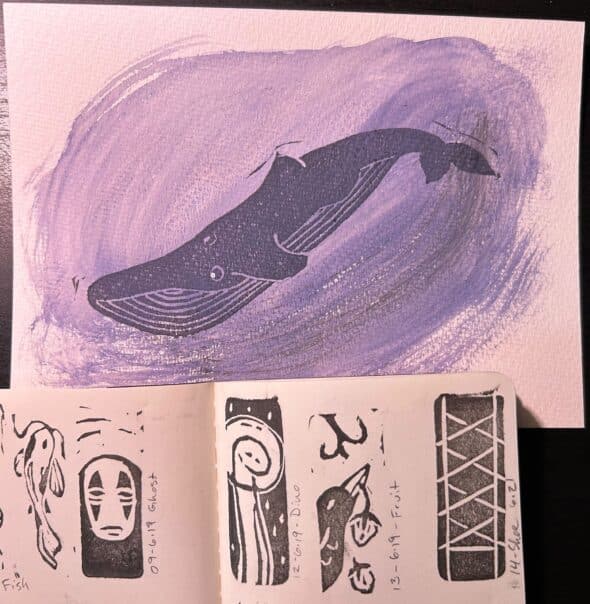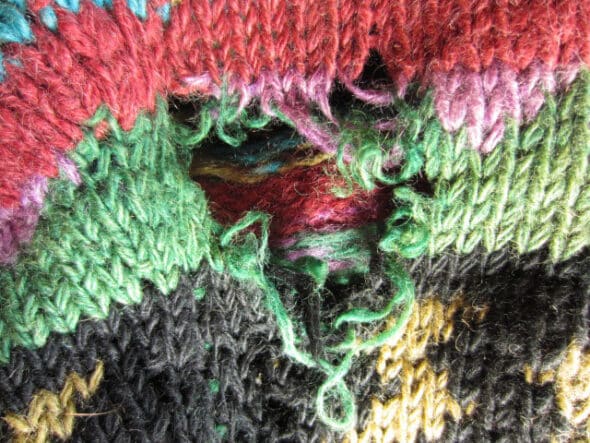Article summary
This is part of a continuing series drawing from experience gained from needlework studies. The first asked readers to consider if they are a process person or a project person. Today, we’ll talk about the importance of making mistakes.
I taught a new class a few years ago. It wasn’t a part of the regular curriculum, but I brought the idea to the shop owner. He loved the idea, and the class filled up quickly. I spent days writing up a comprehensive curriculum and hours knitting little squares of fabric for my students to work with. At the start of class, every student was given a square of hand-knit fabric, a bit of red thread, a needle, and scissors. Everyone was chipper and ready to learn. I couldn’t have asked for a better group.
“Okay everyone, I want you to cut a hole in the middle of your fabric.”
The room shifted immediately from bright-eyed excitement to wide-eyed terror. Everyone in this class knew how long it took me to knit these squares because everyone here knew how to knit. And, I was cheerfully asking them to cut holes. Complaints broke out; they didn’t want to ruin my work.
Why did I start here? Asking them to destroy the work I had done. The simple answer is that this was a class on how to mend knitted fabric, and if we want to mend fabric then we should work with fabric that needs mending.
The longer answer is that I needed them to let go of the perceived perfection this work held. It was an odd little square, and there was little else that it could be used for. The longer they held onto the perfection of what it was, the harder it would be for them to accept the process of mending. They needed to practice making mistakes.
Holding onto Flawed Work
When there’s a flaw in our work, it can be difficult to admit. Humans are great at pattern recognition, which can make spotting mistakes easier. Admitting to those mistakes, however, can be difficult. The process of refactoring can run away from us like water through our fingers. Fix a line of code here, then an error pops up. That unforgiving red line. Fix that error and another piece breaks. It could take other forms, like trying a new database configuration or pushing something experimental to the wrong branch. Error messages crop up, and we want urgently to revert the work to its flawed but functional state.
I’ve watched so many of my knitting students and fellow students in college make these mistakes. It can be difficult to sit patiently with that error message when you’re a new developer. Why is it so difficult to be patient with ourselves when we’re learning?
It can be difficult to hold space when doing this work, to allow our work and ourselves to be imperfect, to allow that hole to be cut in our work. In these moments, it becomes important to learn how to make mistakes and to stop avoiding the progress that they can spur.
Holding onto New Work
Recently, I picked up a new hobby. (I’m always picking up new hobbies, truth be told.) I got into linocutting. After seeing a video online, I picked up some cutting tools, pink erasers, and an ink pad and quickly got to work. I chewed through the material, cutting relief images into the block and stamping every block into my logbook.
Then, I made an ugly block. And I mean ugly. I stared at it for a long time, wondering what on earth I was thinking. How was that supposed to be shoelaces? Why shoelaces?? I took a deep breath, staring forbiddingly at my logbook. It held all of my work, a steadily increasing line of skill as I learned. “How could I add this one to the book?” I held the block over the trash can, ready to drop it in when it hit me. I had to add this one to my book. I was holding onto the perfect log of beautiful creations, and it yielded no room for funk, which meant it yielded no room for growth.

Learning is not linear. It’s a difficult lesson to absorb and one that we’re constantly repeating. It’s also extremely important and can help us to avoid becoming stagnant.
Progress and Letting Go
We have to let go of what we think of as perfect to embrace the good, to embrace growth, patience, and change. Our work will never follow the perfect model of the tutorial, the example, the Instagram post, the inspiration. Isn’t that the best thing?
What mistakes have you made recently that have challenged you?


